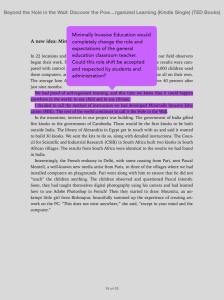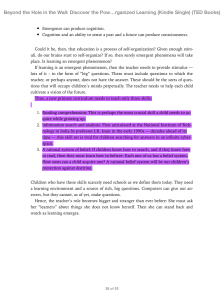As I continued Sugata Mitra’s Beyond the Hole in the Wall: Discover the Power of Self-Organized Learning, the idea of offering SOLEs (self-organized learning environments) in schools was discussed deeper. After so many technological trials with young children that confirmed learning is possible without guidance, Mitra introduces a new curriculum and a redefinition of a teacher’s role in the classroom. He calls this MIE or Minimally Invasive Education (see Image 1).
(Image 1)
Mitra states the teacher’s role should be to provide stimulus or “big” questions. This shift in a teacher’s role would drastically change the curriculum of a general education classroom. Mitra suggests the following redesign of current primary education:
1. Reading comprehension
2. Information search and analysis
3. A rational system of belief
(Image 2)
Beyond these three components (shown in image 2), Mitra explains that computers can give our students the answers but not provide the questions, which would be the sole role of the teacher within the SOLE.
Image 3 highlights what teachers should expect when SOLE’s are first being established in classrooms. Mitra reminds teachers to: be patient with students as they will have less control, to accept the chaos in the beginning as they get used to the educational freedom and to tolerate the noise levels as they tend to rise and fall throughout their experience.
After finishing Mitra’s proposal on SOLEs and MIE, I remain perplexed. I fully support the idea of implementing SOLEs in schools with resources and budgets that will support it. At the same time, I do not fully support the idea that SOLEs should (almost) replace teachers or traditional curriculum. While I agree with Mitra on so many levels on redesigning curriculums so that students develop deeper learning on their own, I do not believe that redefining the role of an educator is one many districts or governments would readily accept. This kind of transformation brings up the following questions:
- Who would finance the SOLE?
- Who redesigns the curriculum standards? Would these be district or state wide?
- How can we assess students on learning produced from SOLE projects if we do not know the answers or outcomes to their questions?
- Would teachers get paid the same amount if their role changed from master to supporter?
There are so many things to consider with such a big change. That being said, I do support SOLEs as an addition or a replacement of other kinds of instructional methods. It would be a dream of mine to teach for a school that could financially offer SOLE resources to teachers in a public high school. Unfortunately, this dream seems out of reach for now.
In the meantime, I will do my best to design and implement my own version of Mitra’s SOLE into my classroom next year, as I admire his vision to give up some of our control over students’ journey to learn.



